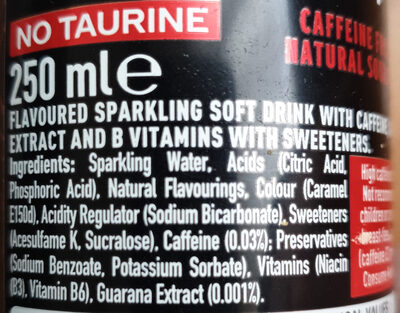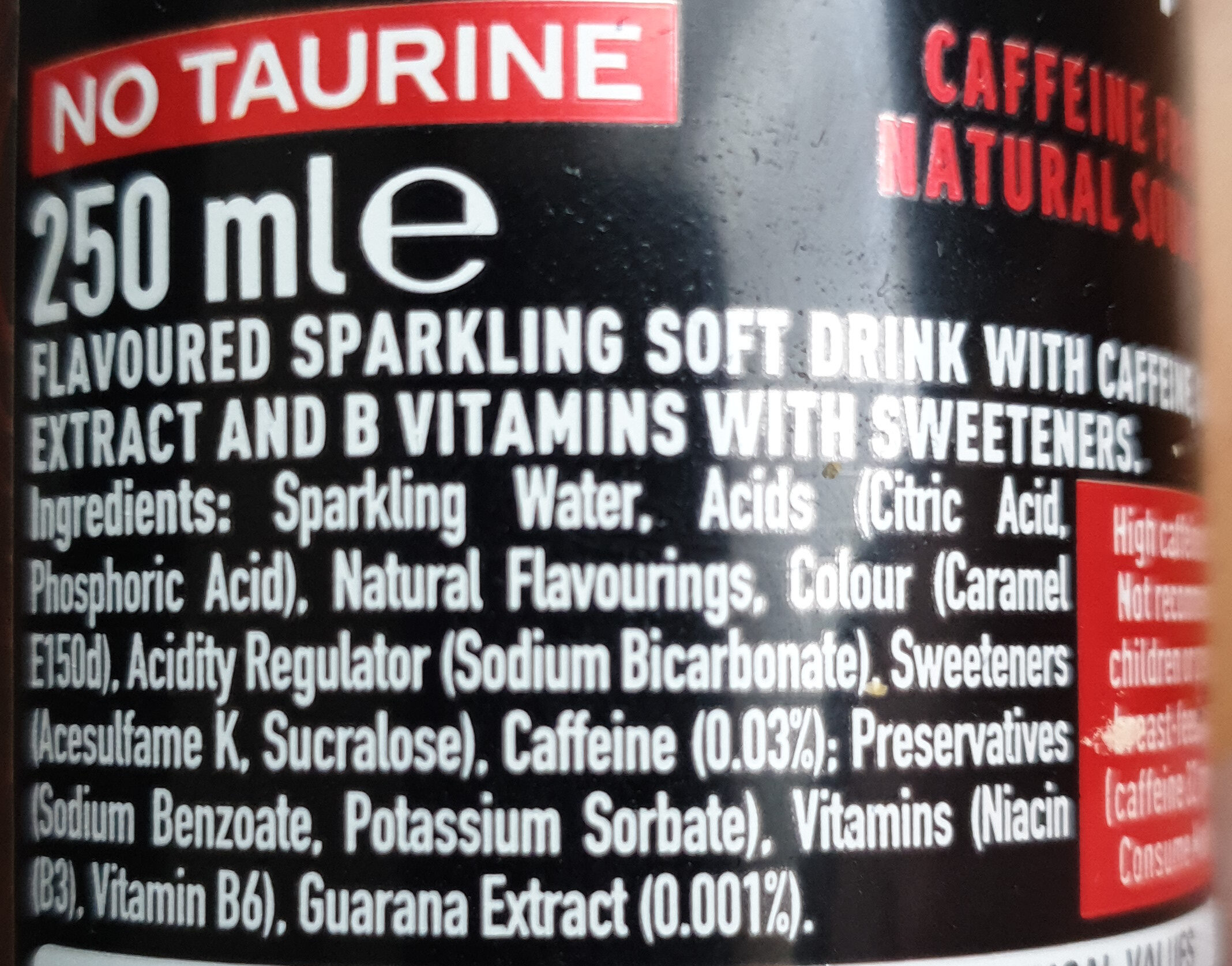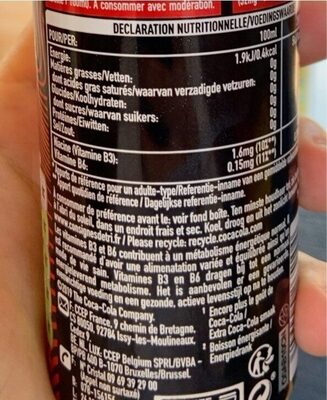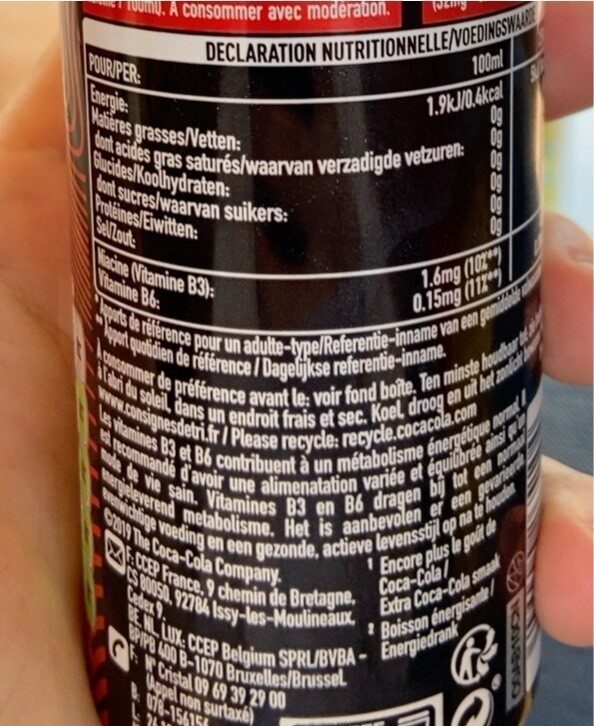Coca-Cola Energy No Sugar - 250ml
Aquesta pàgina del producte no està completa. Podeu ajudar a completar-la editant-la i afegint-hi més dades a partir de les fotos ja disponibles, o fent-ne més amb l'aplicació de androide o iPhone / iPad. Gràcies!
×
Codi de barres: 5449000265104 (EAN / EAN-13)
Nom comú: Cola flavoured energy drink
Quantitat: 250ml
Empaquetament: en:Metal, en:Recyclable Metals, Alumini, en:Can, en:Drink can
Marques: Coca-cola
Categories: Begudes, Begudes carbonatades, Begudes ensucrades artificialment, Refrescs, en:Diet beverages, Begudes sense alcohol, Cola, en:Diet sodas, en:Energy drinks, en:Diet cola soft drink
Botigues: Spar, Centra, carrefour.fr
Països on es va vendre: Bèlgica, França, República d'Irlanda, Luxemburg, Països Baixos, Noruega, Espanya
Matching with your preferences
Entorn
Empaquetament
Transport
Report a problem
Fonts de dades
Producte afegit per kiliweb
Última modificació de la pàgina del producte per bertusdendroef.
La pàgina del producte, també editada per arthurcrbz, corentin-rng, driveoff, feat, inf, odinh, openfoodfacts-contributors, packbot, quechoisir, scanbot, scrypt, teolemon, yuka.R0lzeFBmUVRtZWxWb004WHBCK0YyTkJ1blpTR2ZFYUhHY1lVSWc9PQ, yuka.R0w0RFNMMWVqTXNBdXNZZTlDclRwK2xxM2NLWFJXbXhCdlE3SVE9PQ, yuka.Rm9FRkRvb0x1ZlV0c01FUXp3UDVvUHhLeDcvM1VrR3NCT2xCSVE9PQ, yuka.SEk5WkVvRUIvL291Z3NZa3BSZnYrTXBiNkorWGZrcXdkUGhPSVE9PQ, yuka.SEt4WVBva0JqS0lzeE1NOHB5TFMvZlJiekxLV0JVSzRDK1FESWc9PQ, yuka.UTRJTUhiMGZtOWtMbzhVTzRTN2MrTmtwbjVxa2VEdVpML1l0SVE9PQ, yuka.UXBrUkRwMERnZDhGbHNObit4VDVwbzF3eHNUd1drNldLcmN6SVE9PQ, yuka.UXJrcVBhZ3ZscVVMdy9Fdi9ETHBvZGxhNmNXM1VGN29kTXN3SUE9PQ, yuka.V0t3dFBJQUh0K2NWdTg5azdrL1RwK3RsK0w2V1ltcTVMZXdCSVE9PQ, yuka.V1pzQ0Nyb0ltcU12bHNFZzRoVFV4c0I3NXIzNEF6Mm9CZTRXSWc9PQ, yuka.V3I0dUZhczdvL1VGZ2NObDVnM3gwTjVSMzdENVlVT3lGTEUrSUE9PQ, yuka.VGJ3alRxNDlucWN5eThjYzVoN0svb3hQN29hSFFrT3JPY1U2SUE9PQ, yuka.VjUwcEZvYzQrTXNyaXZZZTREYk55TXBxN0pXNFFseUxFck05SVE9PQ, yuka.VnZwUkRid3pyOWNLa2NZVm9pUFkyZHRWL1kvemRHYVlHZElMSWc9PQ, yuka.VzY1Y1Racy9nL2NSd1BBeTF3bnhwNHA1MnJtV0FVZU9NOHNRSWc9PQ, yuka.WnIwK09ab3RodWRSbzlnWTgwN2JvdjVXM0wrVlhHcW5KY1VXSWc9PQ, yuka.YTUxYkU1UlIvZllwdnNZQTRoYlE2TWx1eHBhdFUwbW1GY2RMSVE9PQ, yuka.YWIxY0FxTUhvT1U2b2ZZeDRUblE1dDlLbVo2cUJqNnRlN0FoSVE9PQ, yuka.YmE5Y1NxOHRtdnhXeFBRUjB4WDQyZmxzM0xPa2JESzRKTTFOSVE9PQ, yuka.sY2b0xO6T85zoF3NwEKvlmBtaOX4kgrqbjnvgl2h2fqxCZDoUelcvdfVEao, yuka.sY2b0xO6T85zoF3NwEKvlmt5cYT0rGmeJj_goWKImdWnAbX2Z_Rt4K_RPag.









